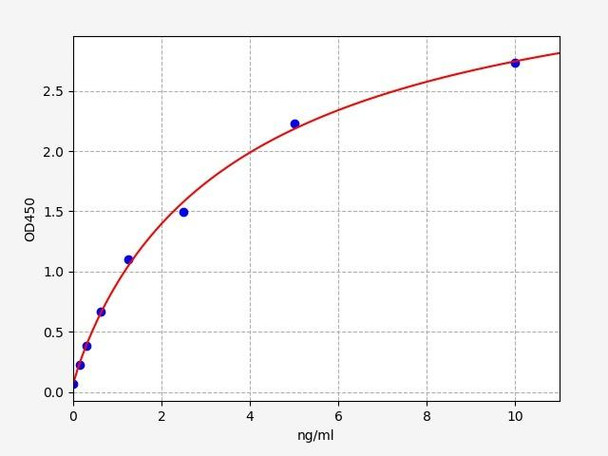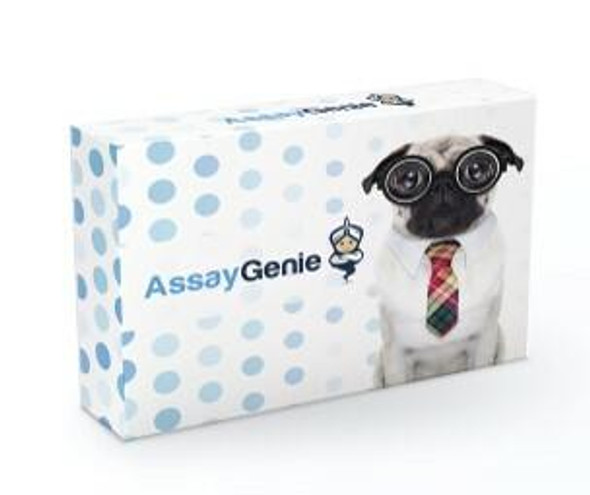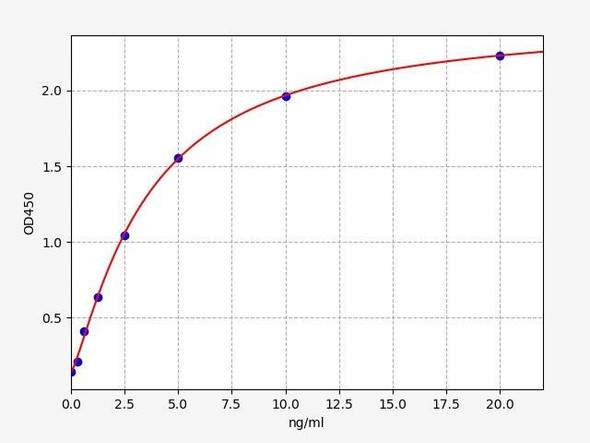Human PDGF Receptor alpha ELISA Kit (HUFI00515)
- SKU:
- HUFI00515
- Product Type:
- ELISA Kit
- Size:
- 96 Assays
- Uniprot:
- P16234
- Sensitivity:
- 0.094ng/ml
- Range:
- 0.156-10ng/ml
- ELISA Type:
- Sandwich
- Synonyms:
- PDGFRA, CD140a, CD140A, CD140a antigen, PDGFR2, PDGF-R-alpha, RHEPDGFRA, alpha-type platelet-derived growth factor receptor, CD140 antigen-like family member A
- Reactivity:
- Human
- Research Area:
- Cell Biology
Description
Human PDGF Receptor alpha ELISA Kit
The Human PDGF Receptor Alpha ELISA Kit is a cutting-edge tool designed for the precise detection of PDGF receptor alpha levels in human serum, plasma, and cell culture supernatants. This advanced kit offers exceptional sensitivity and specificity, guaranteeing accurate and consistent results for a variety of research purposes.The PDGF receptor alpha is a key protein in cell signaling pathways, playing a crucial role in cell growth, proliferation, and differentiation.
Dysregulation of PDGF receptor alpha has been linked to various diseases, including cancer, fibrosis, and atherosclerosis, making it a valuable biomarker for studying these conditions and developing potential therapeutic interventions.With its high performance and reliability, the Human PDGF Receptor Alpha ELISA Kit is a must-have tool for researchers seeking to unravel the intricate mechanisms of PDGF signaling and its implications in health and disease.
| Product Name: | Human PDGF Receptor alpha ELISA Kit |
| Product Code: | HUFI00515 |
| Size: | 96 Assays |
| Alias: | PDGFRA, CD140a, CD140A, CD140a antigen, PDGFR2, PDGF-R-alpha, RHEPDGFRA, alpha-type platelet-derived growth factor receptor, CD140 antigen-like family member A |
| Detection method: | Sandwich ELISA, Double Antibody |
| Application: | This immunoassay kit allows for the in vitro quantitative determination of Human PDGFRA concentrations in serum plasma and other biological fluids. |
| Sensitivity: | 0.094ng/ml |
| Range: | 0.156-10ng/ml |
| Storage: | 4°C for 6 months |
| Note: | For Research Use Only |
| Recovery: | Matrices listed below were spiked with certain level of Human PDGFRA and the recovery rates were calculated by comparing the measured value to the expected amount of Human PDGFRA in samples. | ||||||||||||||||
| |||||||||||||||||
| Linearity: | The linearity of the kit was assayed by testing samples spiked with appropriate concentration of Human PDGFRA and their serial dilutions. The results were demonstrated by the percentage of calculated concentration to the expected. | ||||||||||||||||
| |||||||||||||||||
| CV(%): | Intra-Assay: CV<8% Inter-Assay: CV<10% |
| Component | Quantity | Storage |
| ELISA Microplate (Dismountable) | 8×12 strips | 4°C for 6 months |
| Lyophilized Standard | 2 | 4°C/-20°C |
| Sample/Standard Dilution Buffer | 20ml | 4°C |
| Biotin-labeled Antibody(Concentrated) | 120ul | 4°C (Protect from light) |
| Antibody Dilution Buffer | 10ml | 4°C |
| HRP-Streptavidin Conjugate(SABC) | 120ul | 4°C (Protect from light) |
| SABC Dilution Buffer | 10ml | 4°C |
| TMB Substrate | 10ml | 4°C (Protect from light) |
| Stop Solution | 10ml | 4°C |
| Wash Buffer(25X) | 30ml | 4°C |
| Plate Sealer | 5 | - |
Other materials and equipment required:
- Microplate reader with 450 nm wavelength filter
- Multichannel Pipette, Pipette, microcentrifuge tubes and disposable pipette tips
- Incubator
- Deionized or distilled water
- Absorbent paper
- Buffer resevoir
| Uniprot | P16234 |
| UniProt Protein Function: | PDGFRA: a receptor tyrosine kinase of the PDGFR family that binds members of the platelet-derived growth factor family. The identity of the growth factor bound determines whether the functional receptor is a homodimer or a heterodimer, composed of both PDGFR-alpha and -beta. Ligand binding induces receptor dimerization and autophosphorylation. Particularly important for kidney development since mice heterozygous for the receptor exhibit defective kidney phenotypes. Chromosomal rearrangments activate PDGFRalpha by fusion to BCR, causing atypical chronic myelogenous leukemia (CML), and to FIP1L1, causing idiopathic hypereosinophilic syndrome. Activating point mutations cause a minority of gastrointestinal stromal tumors (GIST). Promoter polymorphisms linked to neural tube defects including spina bifida, verified by mouse mutant model. Inhibitors: Gleevec, Sutent. OMIM: Two alternatively-spliced isoforms have been described. |
| UniProt Protein Details: | Protein type:Protein kinase, tyrosine (receptor); Oncoprotein; Kinase, protein; Membrane protein, integral; Protein kinase, TK; EC 2.7.10.1; TK group; PDGFR family Chromosomal Location of Human Ortholog: 4q12 Cellular Component: microvillus; membrane; integral to plasma membrane; cytoplasm; plasma membrane; nucleus; intrinsic to plasma membrane; external side of plasma membrane Molecular Function:vascular endothelial growth factor receptor activity; protein binding; protein homodimerization activity; platelet-derived growth factor binding; platelet-derived growth factor receptor binding; platelet-derived growth factor alpha-receptor activity; transmembrane receptor protein tyrosine kinase activity; ATP binding Biological Process: estrogen metabolic process; extracellular matrix organization and biogenesis; peptidyl-tyrosine phosphorylation; regulation of chemotaxis; wound healing; nerve growth factor receptor signaling pathway; viral reproduction; protein amino acid autophosphorylation; platelet-derived growth factor receptor signaling pathway; cardiac myofibril assembly; palate development; elevation of cytosolic calcium ion concentration; positive regulation of fibroblast proliferation; Leydig cell differentiation; embryonic digestive tract morphogenesis; luteinization; positive regulation of cell proliferation; male genitalia development; epidermal growth factor receptor signaling pathway; phosphoinositide-mediated signaling; fibroblast growth factor receptor signaling pathway; in utero embryonic development; adrenal gland development; positive regulation of phosphoinositide 3-kinase activity; embryonic cranial skeleton morphogenesis; odontogenesis of dentine-containing teeth; embryonic skeletal morphogenesis; positive regulation of phosphoinositide 3-kinase cascade; cell activation; innate immune response; hemopoietic progenitor cell differentiation; positive regulation of DNA replication; lung development; positive regulation of cell migration Disease: Gastrointestinal Stromal Tumor; Hypereosinophilic Syndrome, Idiopathic |
| NCBI Summary: | This gene encodes a cell surface tyrosine kinase receptor for members of the platelet-derived growth factor family. These growth factors are mitogens for cells of mesenchymal origin. The identity of the growth factor bound to a receptor monomer determines whether the functional receptor is a homodimer or a heterodimer, composed of both platelet-derived growth factor receptor alpha and beta polypeptides. Studies suggest that this gene plays a role in organ development, wound healing, and tumor progression. Mutations in this gene have been associated with idiopathic hypereosinophilic syndrome, somatic and familial gastrointestinal stromal tumors, and a variety of other cancers. [provided by RefSeq, Mar 2012] |
| UniProt Code: | P16234 |
| NCBI GenInfo Identifier: | 129892 |
| NCBI Gene ID: | 5156 |
| NCBI Accession: | P16234.1 |
| UniProt Secondary Accession: | P16234,Q6P4H5, Q96KZ7, Q9UD28, B2RE69, E9PBH0, |
| UniProt Related Accession: | P16234 |
| Molecular Weight: | 1089 |
| NCBI Full Name: | Platelet-derived growth factor receptor alpha |
| NCBI Synonym Full Names: | platelet-derived growth factor receptor, alpha polypeptide |
| NCBI Official Symbol: | PDGFRA |
| NCBI Official Synonym Symbols: | CD140A; PDGFR2; PDGFR-2; RHEPDGFRA |
| NCBI Protein Information: | platelet-derived growth factor receptor alpha; PDGF-R-alpha; CD140a antigen; PDGFRA/BCR fusion; CD140 antigen-like family member A; platelet-derived growth factor receptor 2; alpha-type platelet-derived growth factor receptor; rearranged-in-hypereosinophilia-platelet derived growth factor receptor alpha fusion protein |
| UniProt Protein Name: | Platelet-derived growth factor receptor alpha |
| UniProt Synonym Protein Names: | Alpha platelet-derived growth factor receptor; Alpha-type platelet-derived growth factor receptor; CD140 antigen-like family member A; CD140a antigen; Platelet-derived growth factor alpha receptor; Platelet-derived growth factor receptor 2; PDGFR-2; CD_antigen: CD140a |
| Protein Family: | Platelet-derived growth factor receptor |
| UniProt Gene Name: | PDGFRA |
| UniProt Entry Name: | PGFRA_HUMAN |
*Note: Protocols are specific to each batch/lot. For the correct instructions please follow the protocol included in your kit.
Before adding to wells, equilibrate the SABC working solution and TMB substrate for at least 30 min at 37°C. When diluting samples and reagents, they must be mixed completely and evenly. It is recommended to plot a standard curve for each test.
| Step | Protocol |
| 1. | Set standard, test sample and control (zero) wells on the pre-coated plate respectively, and then, record their positions. It is recommended to measure each standard and sample in duplicate. Wash plate 2 times before adding standard, sample and control (zero) wells! |
| 2. | Aliquot 0.1ml standard solutions into the standard wells. |
| 3. | Add 0.1 ml of Sample / Standard dilution buffer into the control (zero) well. |
| 4. | Add 0.1 ml of properly diluted sample ( Human serum, plasma, tissue homogenates and other biological fluids.) into test sample wells. |
| 5. | Seal the plate with a cover and incubate at 37 °C for 90 min. |
| 6. | Remove the cover and discard the plate content, clap the plate on the absorbent filter papers or other absorbent material. Do NOT let the wells completely dry at any time. Wash plate X2. |
| 7. | Add 0.1 ml of Biotin- detection antibody working solution into the above wells (standard, test sample & zero wells). Add the solution at the bottom of each well without touching the side wall. |
| 8. | Seal the plate with a cover and incubate at 37°C for 60 min. |
| 9. | Remove the cover, and wash plate 3 times with Wash buffer. Let wash buffer rest in wells for 1 min between each wash. |
| 10. | Add 0.1 ml of SABC working solution into each well, cover the plate and incubate at 37°C for 30 min. |
| 11. | Remove the cover and wash plate 5 times with Wash buffer, and each time let the wash buffer stay in the wells for 1-2 min. |
| 12. | Add 90 µl of TMB substrate into each well, cover the plate and incubate at 37°C in dark within 10-20 min. (Note: This incubation time is for reference use only, the optimal time should be determined by end user.) And the shades of blue can be seen in the first 3-4 wells (with most concentrated standard solutions), the other wells show no obvious color. |
| 13. | Add 50 µl of Stop solution into each well and mix thoroughly. The color changes into yellow immediately. |
| 14. | Read the O.D. absorbance at 450 nm in a microplate reader immediately after adding the stop solution. |
When carrying out an ELISA assay it is important to prepare your samples in order to achieve the best possible results. Below we have a list of procedures for the preparation of samples for different sample types.
| Sample Type | Protocol |
| Serum | If using serum separator tubes, allow samples to clot for 30 minutes at room temperature. Centrifuge for 10 minutes at 1,000x g. Collect the serum fraction and assay promptly or aliquot and store the samples at -80°C. Avoid multiple freeze-thaw cycles. If serum separator tubes are not being used, allow samples to clot overnight at 2-8°C. Centrifuge for 10 minutes at 1,000x g. Remove serum and assay promptly or aliquot and store the samples at -80°C. Avoid multiple freeze-thaw cycles. |
| Plasma | Collect plasma using EDTA or heparin as an anticoagulant. Centrifuge samples at 4°C for 15 mins at 1000 × g within 30 mins of collection. Collect the plasma fraction and assay promptly or aliquot and store the samples at -80°C. Avoid multiple freeze-thaw cycles. Note: Over haemolysed samples are not suitable for use with this kit. |
| Urine & Cerebrospinal Fluid | Collect the urine (mid-stream) in a sterile container, centrifuge for 20 mins at 2000-3000 rpm. Remove supernatant and assay immediately. If any precipitation is detected, repeat the centrifugation step. A similar protocol can be used for cerebrospinal fluid. |
| Cell culture supernatant | Collect the cell culture media by pipette, followed by centrifugation at 4°C for 20 mins at 1500 rpm. Collect the clear supernatant and assay immediately. |
| Cell lysates | Solubilize cells in lysis buffer and allow to sit on ice for 30 minutes. Centrifuge tubes at 14,000 x g for 5 minutes to remove insoluble material. Aliquot the supernatant into a new tube and discard the remaining whole cell extract. Quantify total protein concentration using a total protein assay. Assay immediately or aliquot and store at ≤ -20 °C. |
| Tissue homogenates | The preparation of tissue homogenates will vary depending upon tissue type. Rinse tissue with 1X PBS to remove excess blood & homogenize in 20ml of 1X PBS (including protease inhibitors) and store overnight at ≤ -20°C. Two freeze-thaw cycles are required to break the cell membranes. To further disrupt the cell membranes you can sonicate the samples. Centrifuge homogenates for 5 mins at 5000xg. Remove the supernatant and assay immediately or aliquot and store at -20°C or -80°C. |
| Tissue lysates | Rinse tissue with PBS, cut into 1-2 mm pieces, and homogenize with a tissue homogenizer in PBS. Add an equal volume of RIPA buffer containing protease inhibitors and lyse tissues at room temperature for 30 minutes with gentle agitation. Centrifuge to remove debris. Quantify total protein concentration using a total protein assay. Assay immediately or aliquot and store at ≤ -20 °C. |
| Breast Milk | Collect milk samples and centrifuge at 10,000 x g for 60 min at 4°C. Aliquot the supernatant and assay. For long term use, store samples at -80°C. Minimize freeze/thaw cycles. |







